Hammer Toes
Hammer toes are a common foot condition that occurs when the middle joint of the toe becomes bent and stuck in a downward position, causing the toe to resemble a hammer. This condition can affect any toe, but it most commonly occurs in the second or third toe. Hammer toes can cause pain, discomfort, and difficulty wearing shoes.
There are several causes of hammer toes, including genetics, wearing shoes that are too tight or too high, and certain medical conditions such as arthritis and nerve damage. People with flat feet or high arches may also be at a higher risk of developing hammer toes.
The symptoms of hammer toes can include pain, stiffness, and a visible deformity of the affected toe. Corns or calluses may also develop on the toe due to friction or pressure from shoes. In severe cases, the affected toe may become rigid and unable to move.
Treatment for hammer toes may include wearing wider or more comfortable shoes, using pads or cushions to alleviate pressure on the affected toe, and doing exercises to stretch and strengthen the muscles in the toes. In some cases, surgery may be necessary to correct the deformity.
Prevention is key when it comes to hammer toes. It’s important to wear shoes that fit properly and provide enough room for the toes to move freely. Avoid wearing high heels or shoes with a narrow toe box for extended periods of time. Regularly stretching and exercising the feet and toes can also help prevent hammer toes from developing.
If you are experiencing foot pain or notice a deformity in your toes, it’s important to see a podiatrist for an evaluation. They can diagnose and treat hammer toes and other foot conditions, and provide guidance on how to prevent them from occurring in the future.
If you would like to get seen by our board-certified foot and ankle specialists, click here


